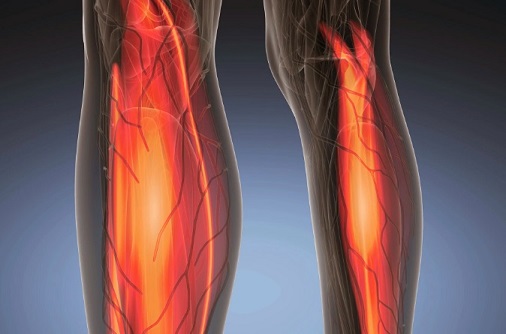Muscle Quality Decline in COVID-19 Survivors Not Tied to Inflammation Levels During Acute Phase
Nikhil Prasad Fact checked by:Thailand Medical News Team Apr 03, 2025 3 weeks, 3 days, 23 hours, 56 minutes ago
Medical News: A groundbreaking new study by researchers from multiple departments at the University of Campinas in Brazil has uncovered troubling long-term consequences of COVID-19 on muscle health - independent of the severity of inflammation during the initial infection. Even months after recovery, many patients continue to suffer from hidden muscular deterioration, including reduced muscle density and fat infiltration deep within their muscles.
 Muscle Quality Decline in COVID-19 Survivors Not Tied to Inflammation Levels During Acute Phase
Muscle Quality Decline in COVID-19 Survivors Not Tied to Inflammation Levels During Acute Phase
The researchers, from the School of Physical Education (DEAFA/UNICAMP), the School of Medical Sciences (FCM/UNICAMP), and the Department of Pulmonology at the University of Campinas, investigated whether systemic inflammation during the acute phase of COVID-19 - measured using the neutrophil-to-lymphocyte ratio (NLR) - played a role in post-recovery muscle deterioration. Surprisingly, they discovered that even patients with lower levels of inflammation experienced significant muscle decline in the months following hospital discharge.
This
Medical News report delves into a retrospective analysis of 60 COVID-19 survivors who were hospitalized between March 2020 and April 2021 and later attended follow-ups 3 to 9 months after recovery. Researchers categorized these patients into two groups based on their NLR: a low-inflammation group (NLR ≤ 4.2) and a high-inflammation group (NLR > 4.2). They then compared computed tomography (CT) scans of skeletal muscle and adipose tissue taken during hospitalization and follow-up visits.
Key Findings Reveal Hidden Damage to Muscle
One of the most important discoveries was a consistent drop in skeletal muscle radiodensity across both groups - regardless of whether patients experienced low or high inflammation during the acute stage. This drop in radiodensity was directly linked to an increase in fat deposits within the muscles, suggesting that long-term metabolic disruptions continue long after the virus has left the body.
More alarmingly, while most would expect the high-inflammation group to fare worse, the study found no statistically significant differences in muscle deterioration between the two groups. Both displayed similar degrees of muscle fat infiltration and reduced muscle quality. Subcutaneous and visceral fat levels, however, remained stable during the follow-up period.
Researchers found that age and the amount of intramuscular fat present during hospitalization were strong predictors of long-term muscle radiodensity loss. Essentially, older patients and those with higher fat content in their muscles during their hospital stay were more likely to suffer prolonged muscle degradation.
Why This Matters for Long COVID Rehabilitation
Muscle radiodensity is a critical marker for overall muscle health, and its reduction can signal muscle weakness, fatigue, and impaired mobility - all commonly reported symptoms in long COVID. The study emphasizes that even those with seemingly mild inflammation during th
eir COVID-19 infection could still face serious post-recovery complications.
Interestingly, while patients with high NLRs during their illness had longer hospital stays and more intensive care interventions, this did not translate to worse long-term muscle health. This finding challenges previous assumptions that systemic inflammation during the acute phase is the main driver of muscle damage in COVID-19 survivors.
The Role of Aging and Fat Infiltration
The study’s regression models revealed that aging and increased fat within muscle tissue were significant contributors to the decline in muscle radiodensity. These fat deposits not only displace healthy muscle fibers but also impair mitochondrial function and energy production, disrupting the body’s ability to rebuild and maintain muscle mass.
Fat infiltration also triggers chronic inflammation and hormonal changes that further disrupt muscle regeneration. This cycle may explain why many older COVID-19 survivors struggle to fully regain their pre-illness strength and endurance, even months after leaving the hospital.
Conclusions and Urgent Implications
The study’s findings underscore an urgent need to revise rehabilitation strategies for COVID-19 survivors. Physical therapy programs must not only target strength recovery but also address deep metabolic and structural changes occurring within muscle tissues. Routine imaging assessments could help clinicians detect early signs of muscle fat infiltration and implement interventions before more permanent damage occurs.
Importantly, the study reveals that traditional inflammation markers such as NLR are not sufficient to predict long-term muscle outcomes, highlighting the need for broader diagnostic criteria and personalized follow-up care.
The study findings were published in the peer reviewed International Journal of Environmental Research and Public Health.
https://www.mdpi.com/1660-4601/22/4/521
For the latest Long COVID News, keep on logging to Thailand
Medical News.
Read Also:
https://www.thailandmedical.news/news/breaking-myalgia-and-muscle-weakness-in-long-covid-is-due-to-sars-cov-2-downregulating-cellular-muscle-functions,-causing-muscle-injury-and-cell-death
https://www.thailandmedical.news/news/covid-19-news-italian-study-shows-that-sarcopenia-is-a-common-manifestation-in-sars-cov-2-infections,-especially-in-those-hospitalized
https://www.thailandmedical.news/news/university-of-florida-researchers-warns-that-covid-19-infections-can-lead-to-rhabdomyolysis-with-extremely-elevated-creatine-kinase-levels
https://www.thailandmedical.news/articles/coronavirus
https://www.thailandmedical.news/pages/thailand_doctors_listings
